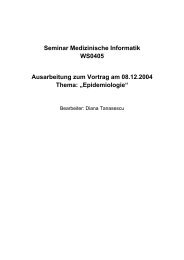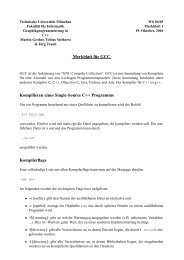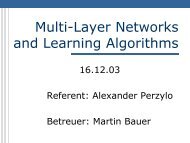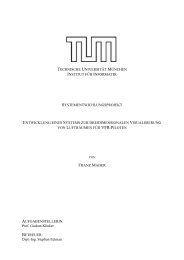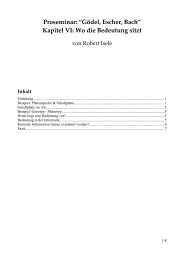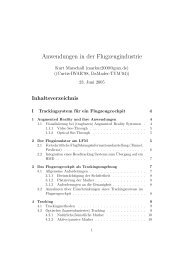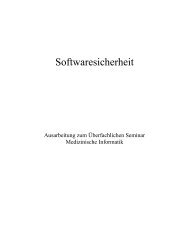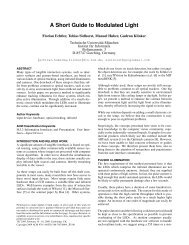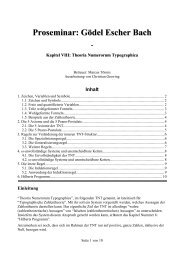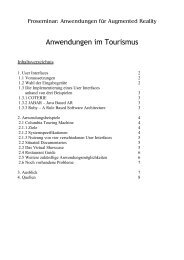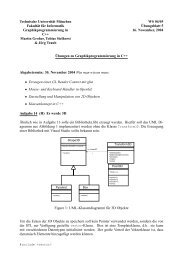Homography-based 2D Visual Tracking and Servoing
Homography-based 2D Visual Tracking and Servoing
Homography-based 2D Visual Tracking and Servoing
You also want an ePaper? Increase the reach of your titles
YUMPU automatically turns print PDFs into web optimized ePapers that Google loves.
S. Benhimane<br />
E. Malis<br />
INRIA<br />
2004, route des Lucioles – B.P. 93,<br />
06902 Sophia Antipolis Cedex, France<br />
Abstract<br />
The objective of this paper is to propose a new homography-<strong>based</strong><br />
approach to image-<strong>based</strong> visual tracking <strong>and</strong> servoing. The visual<br />
tracking algorithm proposed in the paper is <strong>based</strong> on a new efficient<br />
second-order minimization method. Theoretical analysis <strong>and</strong> comparative<br />
experiments with other tracking approaches show that the proposed<br />
method has a higher convergence rate than st<strong>and</strong>ard first-order<br />
minimization techniques. Therefore, it is well adapted to real-time robotic<br />
applications. The output of the visual tracking is a homography<br />
linking the current <strong>and</strong> the reference image of a planar target. Using<br />
the homography, a task function isomorphic to the camera pose<br />
has been designed. A new image-<strong>based</strong> control law is proposed which<br />
does not need any measure of the 3D structure of the observed target<br />
(e.g. the normal to the plane). The theoretical proof of the existence<br />
of the isomorphism between the task function <strong>and</strong> the camera pose<br />
<strong>and</strong> the theoretical proof of the stability of the control law are provided.<br />
The experimental results, obtained with a 6 d.o.f. robot, show<br />
the advantages of the proposed method with respect to the existing<br />
approaches.<br />
KEY WORDS—visual tracking, visual servoing, efficient<br />
second-order minimization, homography-<strong>based</strong> control law<br />
1. Introduction<br />
Vision-<strong>based</strong> control offers a wide spectrum of application<br />
possibilities entailing the use of computer vision <strong>and</strong> control<br />
theories : manipulation, medical robotics, automatic driving,<br />
observation <strong>and</strong> surveillance by aerial robots, etc. The achievement<br />
of such complex applications needs the integration of visual<br />
tracking <strong>and</strong> visual servoing techniques. In this paper, we<br />
describe our contributions to template-<strong>based</strong> visual tracking<br />
algorithms <strong>and</strong> model-free vision-<strong>based</strong> control techniques.<br />
These techniques are integrated in a unifying framework leading<br />
to generic, flexible <strong>and</strong> robust systems that can be used for<br />
a variety of robotic applications.<br />
The International Journal of Robotics Research<br />
Vol. 26, No. 7, July 2007, pp. 661–676<br />
DOI: 10.1177/0278364907080252<br />
c2007 SAGE Publications<br />
<strong>Homography</strong>-<strong>based</strong> <strong>2D</strong><br />
<strong>Visual</strong> <strong>Tracking</strong> <strong>and</strong><br />
<strong>Servoing</strong><br />
1.1. <strong>Visual</strong> tracking<br />
Downloaded from<br />
http://ijr.sagepub.com at INRIA Sophia Documentation on August 29, 2007<br />
© 2007 SAGE Publications. All rights reserved. Not for commercial use or unauthorized distribution.<br />
<strong>Visual</strong> tracking is the core of a vision-<strong>based</strong> control system in<br />
robotics (Hutchinson et al. 1996). When considering real-time<br />
robotic applications, the main requirements of a tracking algorithm<br />
are efficiency, accuracy <strong>and</strong> robustness. <strong>Visual</strong> tracking<br />
methods can be classified into two main groups. The first<br />
group is composed of methods that track local features such<br />
as line segments, edges or contours across the sequence (Isard<br />
<strong>and</strong> Blake 1996 Torr anbd Zisserman 1999 Drummond<br />
<strong>and</strong> Cipolla 1999). These techniques are sensitive to feature<br />
detection <strong>and</strong> cannot be applied to complex images that do not<br />
contain special sets of features to track. The second group is<br />
composed of methods that only make use of image intensity<br />
information. These methods estimate the movement, the deformation<br />
or the illumination parameters of a reference template<br />
between two frames by minimizing an error measure <strong>based</strong><br />
on image brightness. Many approaches have been proposed<br />
to find the relationship between the measured error <strong>and</strong> the<br />
parameters variation. Some methods compute (learn) this relationship<br />
in an off-line processing stage: difference decomposition<br />
(Gleicher 1997 Jurie <strong>and</strong> Dhome 2002), active blobs<br />
(Sclaroff <strong>and</strong> Isidoro 1998), active appearance models (Cootes<br />
et al. 1998). Although these methods are a possible solution<br />
to the problem, they cannot be used in some real-time robotic<br />
applications where the learning step cannot be processed online.<br />
For example, consider a robot moving in an unknown environment<br />
that needs to instantaneously track an object suddenly<br />
appearing in its field of view. Alternatively, there are<br />
methods that minimize the sum-of-squared-differences (SSD)<br />
between the reference template <strong>and</strong> the current image using<br />
parametric models (Lucas <strong>and</strong> Kanade 1981 Hager <strong>and</strong> Behumeur<br />
1998 Shum ans Szeliski 2000 Baker <strong>and</strong> Matthews<br />
2001). Many minimization algorithms could be used to estimate<br />
the transformation parameters. Theoretically, the Newton<br />
method has the highest local convergence rate since it is<br />
<strong>based</strong> on a second-order Taylor series of the SSD. However,<br />
the Hessian computation in the Newton method is time consuming.<br />
In addition, if the Hessian is not positive definite, convergence<br />
problems can occur. In this paper, we propose to use<br />
an efficient second-order minimization method (ESM) (Malis<br />
661
662 THE INTERNATIONAL JOURNAL OF ROBOTICS RESEARCH / July 2007<br />
2004) to solve the problem. The ESM method has a high convergence<br />
rate like the Newton method, but the ESM does not<br />
need to compute the Hessian. Due to its generality, the ESM<br />
algorithm has been successfully used to build an efficient visual<br />
tracking algorithm in Benhimane <strong>and</strong> Malis (2004). Theoretical<br />
analysis <strong>and</strong> comparative simulations with other tracking<br />
approaches show that the method has a higher convergence<br />
rate than other minimization techniques. Consequently,<br />
the ESM algorithm tracks with higher inter-frame movements<br />
<strong>and</strong> it is well-adapted to real-time visual servoing applications.<br />
1.2. <strong>Visual</strong> <strong>Servoing</strong><br />
<strong>Visual</strong> servoing uses the visual information tracked by one or<br />
multiple cameras (Hashimoto 1993 Hutchinson et al. 1996) in<br />
order to control a robot with respect to a target. This robotic<br />
task can be considered as the regulation of a task function e<br />
that depends on the robot configuration <strong>and</strong> the time (Samson<br />
et al. 1991). In this paper, we consider eye-in-h<strong>and</strong> visual<br />
servoing approaches that use the minimum amount of 3D information<br />
about the observed target. Our objective is to design<br />
a visual servoing method that does not need any measure of the<br />
3D structure of the target <strong>and</strong> that only needs the reference image<br />
<strong>and</strong> the current image to compute the task function. In the<br />
literature, the visual servoing methods are generally classified<br />
as follows:<br />
3D visual servoing: the task function is expressed in<br />
the Cartesian space, i.e. the visual information acquired<br />
from the two images (the reference <strong>and</strong> the current images)<br />
is used to explicitly reconstruct the pose (the translation<br />
<strong>and</strong> the rotation in Cartesian space) of the camera<br />
(see, for example, Wilson et al. 1996 Martinet et<br />
al. 1997 Basri et al. 1998 Taylor et al. 2000 Malis<br />
<strong>and</strong> Chaumette 2002). The camera translation (up to a<br />
scale factor) <strong>and</strong> the camera rotation can be estimated<br />
through the Essential matrix (Longuet-Higgins 1981<br />
Hartley 1992 Faugeras 1993). However, the Essential<br />
matrix cannot be estimated when the target is planar or<br />
when the motion performed by the camera between the<br />
reference <strong>and</strong> the current pose is a pure rotation. For<br />
these reasons, it is better to estimate the camera translation<br />
(up to a scale factor) <strong>and</strong> the camera rotation using<br />
a homography matrix (Malis et al. 2000).<br />
<strong>2D</strong> visual servoing: the task function is expressed directly<br />
in the image, i.e. these visual servoing methods do<br />
not need the explicit estimation of the pose error in the<br />
Cartesian space (see, for example, Espiau et al. 1992<br />
Chaumette 2004). A task function isomorphic to the<br />
camera pose is built. As far as we know, except for some<br />
special “ad hoc” target (Cowan <strong>and</strong> Chang 2002), the<br />
isomorphism is generally supposed true without any formal<br />
proof. The real existence of the isomorphism avoids<br />
Downloaded from<br />
http://ijr.sagepub.com at INRIA Sophia Documentation on August 29, 2007<br />
© 2007 SAGE Publications. All rights reserved. Not for commercial use or unauthorized distribution.<br />
situations where the task function is null <strong>and</strong> the camera<br />
is not well positioned (Chaumette 1998). In general, the<br />
task function is built using simple image features such as<br />
the coordinates of interest points. Since the control takes<br />
place in the image, the target has much more chance to<br />
remain visible in the image.<br />
<strong>2D</strong> 1/2 visual servoing: the task function is expressed<br />
of remaining both in the Cartesian space <strong>and</strong> in the image,<br />
i.e. the rotation error is estimated explicitly <strong>and</strong> the<br />
translation error is expressed in the image (see, for example,<br />
Malis et al. 1999 Deguchi 1998). These visual<br />
servoing approaches make it possible not only to perform<br />
the control in the image but also it is possible to<br />
demonstrate the stability <strong>and</strong> the robustness of the control<br />
law (Malis <strong>and</strong> Chaumette 2002).<br />
We notice that, for any of the previous methods, we need a<br />
measure (on-line or off-line) of some 3D information concerning<br />
the observed target. In the <strong>2D</strong> 1/2 visual servoing <strong>and</strong> 3D<br />
visual servoing, the pose reconstruction using the homography<br />
estimation is not unique (two different solutions are possible).<br />
In order to choose the good solution, it is necessary to have an<br />
estimate of the normal vector to the target plane. If the estimate<br />
is very poor we could choose the wrong solution. In the<br />
<strong>2D</strong> visual servoing, when considering for example points as<br />
features, the corresponding depths are necessary to have a stable<br />
control law (Malis <strong>and</strong> Rives 2003). The 3D information<br />
can be obtained on-line. However, the price to pay is a time<br />
consuming estimation step. For example, when the target is<br />
planar, many images are needed to obtain a precise estimation<br />
of the normal to the plane.<br />
In this paper, we present a new <strong>2D</strong> visual servoing method<br />
that makes it possible to control the robot by building a task<br />
function isomorphic to the camera pose in the Cartesian space.<br />
We have demonstrated that isomorphism exists between a task<br />
function e (measured using the homography that matches the<br />
reference target plane image <strong>and</strong> the current one) <strong>and</strong> the camera<br />
pose in the Cartesian space, i.e. the task function e is null if<br />
<strong>and</strong> only if the camera is back to the reference pose. Contrary<br />
to the st<strong>and</strong>ard <strong>2D</strong> visual servoing, we have demonstrated that<br />
we do not need to measure any 3D information in order to<br />
guarantee the stability of the control. The computation of the<br />
control law is quite simple (we do not need either the estimation<br />
of an interaction matrix or the decomposition of the homography)<br />
<strong>and</strong>, similarly to the task function, the control law<br />
does not need any measure of 3D information on the observed<br />
target.<br />
For simplicity, in order to introduce our approach, in this<br />
paper we consider planar targets with unknown 3D information<br />
(i.e. the normal vector to the target plane is unknown).<br />
The generalization of the new approach to non-planar targets is<br />
straightforward since a homography related to a virtual plane<br />
can also be measured if the target is non-planar (Malis et al.<br />
2000).
2. Modeling <strong>and</strong> Notation<br />
As already mentioned in the introduction, we consider eye-inh<strong>and</strong><br />
visual servoing methods. In other words, the robot is controlled<br />
in order to position the current camera frame to the<br />
reference camera frame . We suppose that the only available<br />
information are an image of the scene at the reference<br />
pose <strong>and</strong> a current image of the observed scene (acquired in<br />
real time).<br />
2.1. Perspective Projection<br />
Let be a point in the 3D space. Its 3D coordinates are<br />
[X Y Z ] in the reference frame . Using a perspective<br />
projection model, the point projects on a virtual plane<br />
perpendicular to the optical axis <strong>and</strong> distant one meter from<br />
the projection center in the point m [x y 1] verifying:<br />
m 1<br />
Z (1)<br />
We call m the reference image in normalized coordinates. A<br />
pinhole camera performs a perspective projection of the point<br />
on the image plane [11]. The image coordinates p [u 1] can be obtained from the normalized coordinates<br />
with an affine transformation:<br />
p Km <br />
where the camera intrinsic parameters matrix K can be written<br />
as follows: <br />
f f s u0<br />
<br />
K<br />
0 f r 0<br />
<br />
(3)<br />
0 0 1<br />
where f is the focal length in pixels, s represents the default<br />
of orthogonality between the image frame axis, r is the aspect<br />
ratio <strong>and</strong> [u00] are the coordinates of the principal point (in<br />
pixels).<br />
Let R3 <strong>and</strong> t 3 be respectively the rotation<br />
<strong>and</strong> the translation between the two frames <strong>and</strong> . In the<br />
current frame, the point has the following coordinates<br />
[X Y Z] <strong>and</strong> we have:<br />
Benhimane <strong>and</strong> Malis / <strong>Homography</strong>-<strong>based</strong> <strong>2D</strong> <strong>Visual</strong> <strong>Tracking</strong> <strong>and</strong> <strong>Servoing</strong> 663<br />
(2)<br />
R t (4)<br />
Let u[ux u y uz] be the unit vector corresponding to the<br />
rotation axis <strong>and</strong> (][) be the rotation angle. Setting<br />
ru, we have:<br />
Rexp[r] (5)<br />
where exp is the matrix exponential function <strong>and</strong> where the<br />
skew matrix [r] is defined as follows:<br />
<br />
0 rz ry<br />
<br />
[r] <br />
rz<br />
0 rx<br />
<br />
(6)<br />
ry rx 0<br />
Fig. 1. Projection model <strong>and</strong> homography between two images<br />
of a plane<br />
The point projects on the current normalized imagem in<br />
m[x y 1] where:<br />
m 1<br />
(7)<br />
Z<br />
<strong>and</strong> projects on the current image in p[u 1] where:<br />
pKm (8)<br />
2.2. <strong>Homography</strong> Between Two Images of a Plane<br />
Let us suppose that the point belongs to a plane. Let n <br />
be the normal vector to expressed in the reference frame <br />
<strong>and</strong> d is the distance (at the reference pose) between the plane<br />
<strong>and</strong> the center of projection. If we choose n such that:<br />
then, we can write:<br />
Downloaded from<br />
http://ijr.sagepub.com at INRIA Sophia Documentation on August 29, 2007<br />
© 2007 SAGE Publications. All rights reserved. Not for commercial use or unauthorized distribution.<br />
<br />
n n n 1<br />
d <br />
(9)<br />
n 1 (10)<br />
By using equations (1), (4), (7) <strong>and</strong> (10), we obtain the following<br />
relationship between m <strong>and</strong> m :<br />
Z<br />
mHm<br />
Z where the homography matrix H can be written as follows:<br />
(11)<br />
HRtn (12)<br />
By using equations (2), (8) <strong>and</strong> (11), we obtain the following<br />
relationship between p <strong>and</strong> p :<br />
Z<br />
pGp<br />
Z (13)
664 THE INTERNATIONAL JOURNAL OF ROBOTICS RESEARCH / July 2007<br />
where the matrix G can be written as follows:<br />
GKHK 1 (14)<br />
Given two images <strong>and</strong> of a planar target, it is possible<br />
to compute the homography matrix G up to a scale factor.<br />
We choose the scale factor of the matrices G <strong>and</strong> H such<br />
that the determinants of H <strong>and</strong> G are equal to 1. Then the matrices<br />
H <strong>and</strong> G belong to the Special Linear group3 of<br />
dimension 3. This choice is well justified since detH0 (or<br />
detG0) happens only when the pointpasses though the<br />
plane.<br />
Given the matrices G <strong>and</strong> K, we compute the matrix H up<br />
to a scale factor. Decomposing the matrix H to obtain the rotation<br />
R <strong>and</strong> the translation t has more than one solution [11].<br />
In general, given the matrix K, four solutionsRi ti n i ,<br />
i1 2 3 4 are possible but only two are physically admissible.<br />
An approximation of the real normal vector n to the<br />
target plane makes it possible to choose the good pose.<br />
The matrix Ggi j defines a projective transformation<br />
in the image. A group action w can be defined from3 on<br />
2 :<br />
w :3 2 2 (15)<br />
For all G3, wG is a 2 automorphism:<br />
such that:<br />
wG : 2 2<br />
p <br />
pwGp <br />
<br />
<br />
<br />
pwGp (16)<br />
<br />
g 11 u g 12 g 13<br />
g 31 u g 32 g 33<br />
g 21 u g 22 g 23<br />
g31 u g32 g33<br />
1<br />
<br />
<br />
<br />
<br />
<br />
Let I be the identity matrix. We have the following properties:<br />
p 2 :<br />
p 2 <strong>and</strong>G1 G23:<br />
G3:<br />
wIpp (17)<br />
wG1wG2p wG1wG2p (18)<br />
2.3. The Image Model<br />
wG1G2p (19)<br />
wG 1 wG 1 (20)<br />
A (n m) image can be considered as a (n m) matrix<br />
containing the pixel intensities. The entry u is the<br />
intensity of the pixel located at the line u <strong>and</strong> the column .<br />
We suppose there exists a regular function I :<br />
I : 2 <br />
p [u 1] I u (21)<br />
that verifiesu 1 2 n1 2 m, we have<br />
I p u . For the non-integer values ofu ,<br />
I p is obtained by interpolating u whereu <br />
are integer. In this paper, we suppose that the “image constancy<br />
assumption” is verified, i.e., the two projections p <strong>and</strong> p of<br />
the same 3D point in the images <strong>and</strong> have the same<br />
intensity:<br />
p p (22)<br />
3. ESM <strong>Homography</strong>-<strong>based</strong> <strong>Visual</strong> <strong>Tracking</strong><br />
3.1. Problem Statement<br />
In this section, we suppose that the object we aim to track is<br />
planar. The object is projected in the reference image in<br />
some region of q pixels. This region is called the reference<br />
template. Since the object is supposed to be planar, there is<br />
a homography G that transforms each pixel p i<br />
of the refer-<br />
ence pattern into its corresponding pixel in the current image<br />
. <strong>Tracking</strong> the reference template in the current image consists<br />
in finding the projective transformation G3 that<br />
transforms each pixel p i of the reference pattern into its corresponding<br />
pixel in the current image, i.e. finding the homography<br />
G such thati1 2 q:<br />
w G p i p i (23)<br />
Suppose that we have an approximationG of G, the problem<br />
consists in finding an incremental transformation Gx (where<br />
the81 vector x contains a local parameterization of3)<br />
such that the difference between the region of the image<br />
(transformed with the composition wGwGx) <strong>and</strong> the<br />
corresponding region in the image is null. <strong>Tracking</strong> consists<br />
in finding the vector x such thati1 2 q, we have:<br />
<br />
yix wGwGxp i <br />
p i0 (24)<br />
Let yx be the (q1) vector containing the image differences:<br />
yx y1x y2x yqx (25)<br />
Then, the problem consists in finding xx0 verifying:<br />
Downloaded from<br />
http://ijr.sagepub.com at INRIA Sophia Documentation on August 29, 2007<br />
© 2007 SAGE Publications. All rights reserved. Not for commercial use or unauthorized distribution.<br />
yx00 (26)<br />
Since the matrixG3, i.e. detG1 by construction,<br />
it is evident that the solution to the problem verifies:<br />
Gx0G 1 G (27)
The system (26) is generally nonlinear <strong>and</strong> many methods<br />
could be used to solve the problem. However, due to real-time<br />
constraints the problem is often solved by using an iterative<br />
minimization after linearizing the image signal with respect to<br />
the transformation parameters.<br />
3.2. System Linearization<br />
Let theq 8 matrix Jx be the Jacobian matrix, i.e it is the<br />
gradient of the vector yx with respect to the vector x:<br />
Jxxyx (28)<br />
Let theq 8 matrix Mx1 x2 defined as:<br />
Mx1 x2x1 Jx1x2 (29)<br />
It is possible to linearize the vector yx about x0 using the<br />
second-order Taylor series approximation:<br />
yxy0J0 x 1<br />
2 M0 x xOx3 (30)<br />
where Oxi is a remainder of order i. For xx0, the system<br />
(26) can be written:<br />
<br />
yx0y0 J0 1<br />
<br />
M0 x0 x0 0 (31)<br />
2<br />
3.3. Iterative Minimization<br />
In general, the system (31) is solved using a sum-of-squared<br />
differences minimization. It consists in solving iteratively the<br />
following function:<br />
fx 1<br />
1<br />
y0J0x<br />
2 2 M0 xx2 (32)<br />
A necessary condition for a vector xx0 to be a local or a<br />
global minimum of the cost function f is that the derivative of<br />
f is null at xx0, i.e.:<br />
x fx xx0 0 (33)<br />
St<strong>and</strong>ard Newton minimization solves the system (33) iteratively.<br />
At each iteration, an incremental x0 is estimated:<br />
x0S 1 J0 y0 (34)<br />
where the88 matrix S depends on the Hessian matrices<br />
<strong>and</strong> is supposed to be invertible:<br />
2 yix<br />
x 2<br />
SJ0 J0<br />
q<br />
i0<br />
2 yix<br />
x 2<br />
<br />
<br />
<br />
Benhimane <strong>and</strong> Malis / <strong>Homography</strong>-<strong>based</strong> <strong>2D</strong> <strong>Visual</strong> <strong>Tracking</strong> <strong>and</strong> <strong>Servoing</strong> 665<br />
x0<br />
yi0 (35)<br />
Once x0 estimated, the homography matrixG is updated as<br />
follows:<br />
GG Gx0 (36)<br />
where the arrow denotes the update assignment (the left<br />
<strong>and</strong> the right versions ofG are respectively the new <strong>and</strong> the<br />
old estimates).<br />
The loop stops if the estimated value of x0 becomes too<br />
small.<br />
The Newton minimization has a quadratic convergence in<br />
the neighborhood of x0. In addition, if the cost function fx<br />
is convex quadratic, the global minimum can be reached in<br />
only one iteration. However, when the cost function fx is<br />
not convex quadratic, convergence problems may happen if<br />
the matrix S is not definite positive. Furthermore, Newton<br />
method needs the computation of the Hessian matrices. For<br />
these reasons, many methods have been proposed to approximate<br />
the matrix S with a definite positive matrixS. Then, instead<br />
of being second-order approximations (as the Newton<br />
method does), these methods are first-order approximations<br />
(30). Among these methods, there are:<br />
Gradient descent:<br />
Gauss–Newton:<br />
Levenberg–Marquardt:<br />
Downloaded from<br />
http://ijr.sagepub.com at INRIA Sophia Documentation on August 29, 2007<br />
© 2007 SAGE Publications. All rights reserved. Not for commercial use or unauthorized distribution.<br />
SS I where 0 (37)<br />
SSJ0 J0 (38)<br />
SSJ0 J0 I where 0 (39)<br />
In the literature, many template-<strong>based</strong> tracking algorithm<br />
use such approximations. For example, in Shum <strong>and</strong> Szeleski<br />
(2000), the authors use the Gauss–Newton approximation with<br />
a compositional homography update (as described in the equation<br />
(36)). In Lucas <strong>and</strong> Kanade (1981) <strong>and</strong> Shi <strong>and</strong> Tomasi<br />
(1994) the authors use also the Gauss–Newton approximation<br />
with an additional homography update.<br />
There are also algorithms that approximate the current Jacobian<br />
J0 (which varies from one iteration to another) by<br />
a constant Jacobian (Hager <strong>and</strong> Belhumeur 1998 Baker <strong>and</strong><br />
Matthews 2001):<br />
J0J (40)<br />
This makes the algorithm faster since the matrix J0 <strong>and</strong> the<br />
inverse of the matrixS are computed once for all. However,<br />
the price to pay is a smaller convergence region.<br />
The second-order approximation of the cost function is<br />
used very little since it needs the computation of the Hessian<br />
matrices <strong>and</strong> convergence problems may happen if the matrix<br />
S is not definite positive.
666 THE INTERNATIONAL JOURNAL OF ROBOTICS RESEARCH / July 2007<br />
3.4. The ESM <strong>Visual</strong> <strong>Tracking</strong> Algorithm<br />
We present now an efficient algorithm that solves the second<br />
order approximation of the system (26), this method will be<br />
called “ESM visual tracking algorithm”. The proposed method<br />
does not need the computation of the Hessian matrices.<br />
3.4.1. The Lie Algebra(3)<br />
The projective transformation matrix Gx is in the group<br />
3 which is a Lie group. The Lie algebra associated to this<br />
group is3. Matrices in this algebra are33 with a null<br />
trace. The exponential map is a homeomorphism between a<br />
neighborhood of I3 <strong>and</strong> a neighborhood of the null<br />
matrix 03.<br />
LetA1 A2 A8 be a basis of the the Lie algebra3.<br />
A matrix Ax3 can be written as follows:<br />
Ax<br />
8<br />
xiAi (41)<br />
A projective transformation Gx3 in the neighborhood<br />
of I can be parameterized as follows:<br />
i1<br />
GxexpAx<br />
<br />
i0<br />
We use the following3 basis matrices:<br />
A1<br />
A3<br />
A5<br />
A7<br />
<br />
<br />
<br />
<br />
<br />
<br />
<br />
<br />
<br />
<br />
<br />
<br />
<br />
<br />
<br />
<br />
0 0 1<br />
0 0 0<br />
0 0 0<br />
0 1 0<br />
0 0 0<br />
0 0 0<br />
1 0 0<br />
0 1 0<br />
0 0 0<br />
0 0 0<br />
0 0 0<br />
1 0 0<br />
<br />
<br />
<br />
<br />
A2<br />
<br />
<br />
<br />
<br />
<br />
<br />
<br />
A4<br />
<br />
<br />
<br />
<br />
<br />
<br />
<br />
A6<br />
<br />
<br />
<br />
<br />
<br />
<br />
A8<br />
<br />
<br />
<br />
1<br />
i! Axi (42)<br />
<br />
0 0 0<br />
0 0 1<br />
0 0 0<br />
0 0 0<br />
1 0 0<br />
0 0 0<br />
<br />
<br />
<br />
<br />
<br />
<br />
<br />
<br />
0 0 0<br />
0 1 0<br />
0 0 1<br />
0 0 0<br />
0 0 0<br />
0 1 0<br />
<br />
<br />
<br />
<br />
<br />
<br />
<br />
<br />
3.4.2. The ESM Iterative Minimization<br />
Downloaded from<br />
http://ijr.sagepub.com at INRIA Sophia Documentation on August 29, 2007<br />
© 2007 SAGE Publications. All rights reserved. Not for commercial use or unauthorized distribution.<br />
We use the homography Lie algebra parameterization described<br />
above. In the second-order Taylor series approximation<br />
of the vector yx about x0 (30), the computation of the matrix<br />
M0 x needs the computation of the Hessian matrices of<br />
the vector yx. However, by using the first-order Taylor series<br />
approximation of the vector Jx about x0:<br />
JxJ0M0 xOx 2 (43)<br />
the equation (30) can be written without computing the<br />
Hessian matrices of yx:<br />
yxy0 1<br />
2 J0Jx xOx3 (44)<br />
It is a second-order approximation of yx about x 0. For<br />
xx0, we have:<br />
yx0y0 1<br />
2 J0Jx0 x0 (45)<br />
Given the expressions for J0 <strong>and</strong> Jx0 in Appendix A the<br />
sum of the Jacobians can be written as follows:<br />
J0Jx0JJwJG JJwJG0 (46)<br />
Using the formula (72), the equation (45) can be written as<br />
follows:<br />
yx0y0 1<br />
2 J J Jw JG x0 (47)<br />
Using this approximation, the system (26) can be solved iteratively<br />
using the least-square method. Let Jesm be the following<br />
matrix:<br />
Jesm 1<br />
2 J J Jw JG (48)<br />
The cost function to be minimized can be written as follows:<br />
fx 1<br />
2 y0Jesmx 2 (49)<br />
This cost function has a local or a global minimum in xx0<br />
verifying:<br />
x0 J esmy0 (50)<br />
where J esm is the pseudo-inverse of Jesm. Iteratively, we estimate<br />
x0, then we updateG (36). For eachG, y0 <strong>and</strong> J are<br />
computed. The loop stops when x0 becomes too small.<br />
Given G, using an approximation of the matrix K, we compute<br />
the matrix HK 1 GK. Then, the matrix H is used for<br />
computing the visual servoing control law described in the next<br />
section.
4. <strong>Homography</strong>-<strong>based</strong> <strong>2D</strong> <strong>Visual</strong> <strong>Servoing</strong><br />
In this section, we present a new visual servoing method that<br />
does not need any measure of the structure of the observed<br />
target. In order to do that, we have to define an isomorphism<br />
between the camera pose <strong>and</strong> the visual information extracted<br />
from the reference image <strong>and</strong> the current image only. Given<br />
this isomorphism, we compute a stable control law which also<br />
relies on visual information only.<br />
4.1. Isomorphism Between Task Function <strong>and</strong> Camera Pose<br />
The two frames <strong>and</strong> coincide, if <strong>and</strong> only if, the matrix<br />
H is equal to the identity matrix I. Using the homography<br />
matrix H, we build a task function e 6 locally isomorphic<br />
to the camera pose (since we have restricted). The<br />
task function e is null, if <strong>and</strong> only if the camera is back to the<br />
reference pose.<br />
Theorem 1 Task function isomorphism.<br />
Let R be the rotation matrix <strong>and</strong> t be the translation vector<br />
between et, where Rexp <br />
[u] , ][ <strong>and</strong><br />
let [X Y Z ] be the coordinates of a certain point<br />
in the reference frame . We define the task function<br />
e as follows:<br />
<br />
<br />
e tRI Z<br />
e <br />
(51)<br />
e<br />
2 sinu[n ] t<br />
where n is the normal vector to the plane expressed in the<br />
reference frame . The function e is isomorphic to the camera<br />
pose, i.e. e0, if <strong>and</strong> only if, 0 et t0.<br />
The proof of the theorem is given in Appendix B. We can<br />
demonstrate also that the task function e can be computed using<br />
the two images <strong>and</strong> only, i.e. without directly measuring<br />
the 3D structure of the target (n et Z ). Given the homography<br />
matrix H, we can write:<br />
e HIm <br />
Benhimane <strong>and</strong> Malis / <strong>Homography</strong>-<strong>based</strong> <strong>2D</strong> <strong>Visual</strong> <strong>Tracking</strong> <strong>and</strong> <strong>Servoing</strong> 667<br />
(52)<br />
[e] HH (53)<br />
See the Appendix B for the proof of these equations. If we have<br />
e 0, then the two projections <strong>and</strong> of the same 3D<br />
point coincide. And if we have e 0, then the homography<br />
matrix H is symmetric.<br />
In this paper, for simplicity, we consider only this isomorphism.<br />
However, there exists a group of isomorphisms that can<br />
be built using the homography matrix H. For example, we can<br />
choose the task function e as follows:<br />
e m Hm <br />
m m mm<br />
[e] HH <br />
where m 1<br />
n<br />
n i1 mi <strong>and</strong> m 1<br />
n<br />
n i1 m i (i.e. the center<br />
of gravity of a cloud of points), <strong>and</strong> where m i <strong>and</strong> mi are corresponding<br />
points. We can demonstrate also that this function<br />
is isomorphic to the camera pose.<br />
4.2. The Control Law<br />
The derivative of the task function with respect to timee can<br />
be written as follows:<br />
<br />
<br />
eL<br />
(54)<br />
<br />
where is the camera translation velocity,is the camera<br />
rotation velocity <strong>and</strong> L is the (66) interaction matrix. The<br />
matrix L can be written as follows:<br />
<br />
L<br />
1Z [e m ] <br />
[n ] [n ] [t] 2L<br />
where the (33) matrix L can be written as follows:<br />
L I sin<br />
2<br />
[u] sin 2<br />
(55)<br />
<br />
<br />
2I[u]<br />
2<br />
2 (56)<br />
The interaction matrix L does not need to be estimated. It is<br />
only useful to analytically prove the following theorem on the<br />
stability of the control law:<br />
Theorem 2 Local stability.<br />
The control law:<br />
<br />
<br />
<br />
<br />
I<br />
<br />
0<br />
<br />
0 I<br />
where 0 <strong>and</strong> 0 is locally stable.<br />
e<br />
e<br />
<br />
(57)<br />
See the Appendix B for the proof. This control law only depends<br />
on the task function. Consequently, it can be computed<br />
using the two images <strong>and</strong> . With such a control law, the<br />
task function e converges exponentially to 0. The local stability<br />
of the control law is guaranteed for all n <strong>and</strong> for all .<br />
By choosing 0 <strong>and</strong> 0 such that, one can<br />
make e <strong>and</strong> e converge at different speeds.<br />
5. Simulation Results<br />
5.1. Advantages of the ESM Algorithm<br />
Downloaded from<br />
http://ijr.sagepub.com at INRIA Sophia Documentation on August 29, 2007<br />
© 2007 SAGE Publications. All rights reserved. Not for commercial use or unauthorized distribution.<br />
The main advantage of having a second-order approximation is<br />
the high convergence rate. Another advantage is the avoidance<br />
of local minima close to the global one (i.e. when the secondorder<br />
approximation is valid). Here, we show these advantages<br />
with the help of two simple examples.
668 THE INTERNATIONAL JOURNAL OF ROBOTICS RESEARCH / July 2007<br />
5.1.1. High Convergence Rate<br />
Consider a (41) vector function yx quadratic in a (21)<br />
parameter vector x. The simulation is repeated 4 times with<br />
different starting points: x01515. Suppose we<br />
can measure the constant Jacobian J0 <strong>and</strong> the varying Jacobian<br />
Jx0. The results for six different minimization methods<br />
are given in Figure 2. The contours represent isolines of the<br />
SSD (i.e. the cost function has the same value for each point<br />
of the contour) while the other lines represent the paths for<br />
each starting point. Obviously, the ideal path (i.e. the shortest<br />
one) would be a straight line from x0 to 0. Figure 2(a)<br />
shows that the varying Steepest Descent method always moves<br />
in a direction perpendicular to the isolines. For this reason, it<br />
has a slow convergence rate <strong>and</strong> cannot reach the minimum<br />
following a straight line. The paths for the constant Steepest<br />
Descent method are even longer (see the path lengths in<br />
Figure 2(b)). The constant (Figure 2(d)) <strong>and</strong> the varying (Figure<br />
2(c)) Gauss–Newton methods perform better than the constant<br />
<strong>and</strong> the varying Steepest Descent methods respectively.<br />
In fact, the constant <strong>and</strong> the varying Gauss–Newton methods<br />
use a rough approximation of the Hessian. An ill conditioned<br />
<strong>and</strong> indefinite Hessian matrix causes oscillations of the Newton<br />
method in Figure 2(e). Finally, the ESM method gives the<br />
best solution since the paths in Figure 2(f) are straight lines.<br />
Indeed, when the function yx is exactly quadratic we can<br />
correctly estimate the displacement in only one step <strong>and</strong> thus<br />
the correct descent direction regardless of the shape of the isolines.<br />
5.1.2. Avoiding Local Minima<br />
In the second simulation, we choose a different quadratic function<br />
yx such that the corresponding SSD cost function has a<br />
local minimum very close to the global minimum. The Newton<br />
method <strong>and</strong> all methods with varying Jacobian fall into<br />
the local minimum when the starting point is close to it (see<br />
Figures 3(a), 3(c) <strong>and</strong> 3(e)). In this case, methods with constant<br />
Jacobian could diverge (see Figures 3(b) <strong>and</strong> 3(d)). Indeed,<br />
the constant Jacobian approximation is valid only in a<br />
neighborhood of the true solution. On the other h<strong>and</strong>, the ESM<br />
method follows the shortest path (see Figure 3(f)). Thus, if<br />
yx is locally quadratic the ESM method is able to avoid local<br />
minima. Obviously, if the local minimum is far from the<br />
true minimum the second-order approximation is not valid any<br />
more.<br />
5.2. Comparison with St<strong>and</strong>ard <strong>Tracking</strong> Methods<br />
We compared the ESM method with the constant Gauss Newton<br />
method (CGN) proposed in Baker <strong>and</strong> Matthews (2001)<br />
<strong>and</strong> with the varying Gauss Newton method (VGN) proposed<br />
Downloaded from<br />
http://ijr.sagepub.com at INRIA Sophia Documentation on August 29, 2007<br />
© 2007 SAGE Publications. All rights reserved. Not for commercial use or unauthorized distribution.<br />
Fig. 2. Comparing the behavior of 6 different minimization<br />
methods.<br />
in Shum <strong>and</strong> Szeliski (2000). We have used the Matlab software<br />
available on the web page of Dr Simon Baker at the<br />
Robotics Institute of the Carnegie Mellon University. Thus,<br />
the performance of the algorithms were compared with the<br />
same experimental setup. In order to have a ground truth,<br />
the ESM algorithm was tested by warping the image shown<br />
in Figure 4(a). The (124124) template illustrated in Figure<br />
4(b) was selected in the center of the image. The computational<br />
complexity of the ESM algorithm is equivalent to<br />
the VGN method, which is higher than the CGN method. In<br />
order to have the same execution time per iteration, we can<br />
use a smaller subset (25 %) of the template for computing<br />
the Jacobians <strong>and</strong> the estimated displacement. The template<br />
was warped 1000 times using different r<strong>and</strong>om homographies.<br />
Similarly to Baker <strong>and</strong> Matthews (2001), the homography was<br />
computed by adding a Gaussian noise to the coordinates of<br />
the four corners of the template. The st<strong>and</strong>ard deviation of<br />
the Gaussian noise was increased from 1 to 12. Figure 4(c)<br />
plots the frequencies of convergence (% over 1000 tests). As
Fig. 3. Comparing the behavior of 6 different minimization<br />
methods.<br />
increases, the frequency of convergence of the CGN <strong>and</strong><br />
the VGN methods decay quicker than the frequency of convergence<br />
of the ESM method. At the final 12, the frequency<br />
of convergence of the CGN <strong>and</strong> the VGN methods are only<br />
40% while the frequency of convergence of the ESM method<br />
is 80%. Figure 4(e) shows the average convergence rate (over<br />
the converged tests) of the algorithms for 12. The initial<br />
value of the SSD is the same for the three algorithms but the<br />
speed of convergence of the ESM method is much higher. This<br />
means that we can perform real-time tracking at higher rates.<br />
Since our objective is to track objects in real time, it is very<br />
important to measure the residuals after each minimization. Indeed,<br />
since the number of iterations is fixed by the frame rate,<br />
the error will cumulate. Figure 4(f) plots the average residual<br />
over all the tests for which the algorithms did not diverge<br />
(we consider that the algorithm diverges when the final SSD<br />
is bigger than the initial SSD). Obviously the SSD increases<br />
with the amplitude of the initial displacement. However, the<br />
ESM method performs much better than the CGN method <strong>and</strong><br />
Benhimane <strong>and</strong> Malis / <strong>Homography</strong>-<strong>based</strong> <strong>2D</strong> <strong>Visual</strong> <strong>Tracking</strong> <strong>and</strong> <strong>Servoing</strong> 669<br />
Fig. 4. Comparison between ESM <strong>and</strong> st<strong>and</strong>ard methods.<br />
the VGN method. Finally, we tested the robustness of the algorithms<br />
to sampling. Figure 4(d) plots the frequency of convergence<br />
for 12 against the sampling rate r between the<br />
size of the subset used in the algorithm <strong>and</strong> the size of the template,<br />
e.g. for 1/1 we use all the template while for 1/10 we use<br />
1 % of the template (1 pixel used every 10 pixels of the image<br />
per line <strong>and</strong> per column). The ESM algorithm is more robust<br />
to sampling. For r 110, the frequency of convergence of<br />
the ESM method is almost the same as the two other methods<br />
without sampling. Thus, we can obtain the same frequency of<br />
convergence with a faster algorithm.<br />
6. Experimental Results<br />
6.1. <strong>Visual</strong> <strong>Tracking</strong><br />
Downloaded from<br />
http://ijr.sagepub.com at INRIA Sophia Documentation on August 29, 2007<br />
© 2007 SAGE Publications. All rights reserved. Not for commercial use or unauthorized distribution.<br />
The second-order tracking was tested on sequences with moving<br />
planar objects. Five images were extracted from each sequence<br />
<strong>and</strong> they are shown in the first row of Figure 5 <strong>and</strong>
670 THE INTERNATIONAL JOURNAL OF ROBOTICS RESEARCH / July 2007<br />
Fig. 5. <strong>Tracking</strong> a template on a planar object.<br />
Fig. 6. <strong>Tracking</strong> a template on the back of a car.<br />
Figure 6. In the first experiment, the template to track was a<br />
(150150) window shown in Figure 5(f). The red windows in<br />
the first row of Figure 5 are warped back <strong>and</strong> shown in the second<br />
row of Figure 5. Despite illumination changes <strong>and</strong> image<br />
noise, the warped windows are very close to the reference template<br />
proving that the tracking is accurately performed. During<br />
the sequence, a generic projective motion <strong>and</strong> several light<br />
variations were observed. For example, Figures 5(b) <strong>and</strong> 5(c)<br />
show translation <strong>and</strong> rotation around thez <strong>and</strong>x axis respectively,<br />
while Figure 5(d) <strong>and</strong> 5(e) show a rotation around they<br />
<strong>and</strong> varying illumination (the image becomes darker, the image<br />
becomes lighter). In the second experiment, we tracked a<br />
(4343) template on the back of a car with a camera mounted<br />
on another car (see Figure 6(a) to (e)). Again, the tracking is<br />
accurately performed in spite of the template changes due to<br />
people movement that we can see through the window of the<br />
car (see Figure 6(f) to (j)).<br />
6.2. <strong>Visual</strong> <strong>Tracking</strong> <strong>and</strong> <strong>Servoing</strong><br />
Downloaded from<br />
http://ijr.sagepub.com at INRIA Sophia Documentation on August 29, 2007<br />
© 2007 SAGE Publications. All rights reserved. Not for commercial use or unauthorized distribution.<br />
We tested the proposed visual servoing on the 6 d.o.f. robot of<br />
the LAGADIC research team at INRIA Rennes. The robot is<br />
accurately calibrated <strong>and</strong> it provides a ground truth for measuring<br />
the accuracy of the positioning task. A calibrated camera<br />
was mounted on the end-effector of the robot <strong>and</strong> a reference
Fig. 7. Experiment 1: Camera positioning with respect to a<br />
planar object without approximating the normal vector to the<br />
object plane.<br />
image was captured at the reference pose. The positioning a<br />
planar target was used for the positioning task. We started from<br />
another pose (the initial pose) which allowed us to see the object<br />
from a different angle. The robot was controlled using the<br />
control law (57) with 01 in order to return to the<br />
reference pose. At the initial pose (the translation displacement<br />
is 0.68 m <strong>and</strong> the rotation displacement is 96 degrees), we can<br />
see the projective transformation of the area of interest (the<br />
rectangle in the center in Figures 7(a) <strong>and</strong> 7(b) corresponds<br />
to the desired position). We used the ESM 1 visual tracking<br />
algorithm (Benhimane <strong>and</strong> Malis 2004) to track the area of interest<br />
<strong>and</strong> at the same time to estimate the homography matrix<br />
H. Given the matrix H, the control law was computed. As the<br />
control point (m in the equation (52)) we used the center of<br />
gravity of the area. At the convergence, the robot is back to its<br />
1. The ESM visual tracking software can be downloaded from the following<br />
web-page: http://www-sop.inria.fr/icare/personnel/malis/software/ESM.html<br />
Benhimane <strong>and</strong> Malis / <strong>Homography</strong>-<strong>based</strong> <strong>2D</strong> <strong>Visual</strong> <strong>Tracking</strong> <strong>and</strong> <strong>Servoing</strong> 671<br />
Downloaded from<br />
http://ijr.sagepub.com at INRIA Sophia Documentation on August 29, 2007<br />
© 2007 SAGE Publications. All rights reserved. Not for commercial use or unauthorized distribution.<br />
Fig. 8. Experiment 2: Camera positioning with an uncalibrated<br />
camera without approximating the normal vector to the object<br />
plane.<br />
reference pose <strong>and</strong> the visual information coincides with the<br />
visual information of the reference pose (see figure 7(b)). The<br />
control law is stable: the translation figures 7(c) <strong>and</strong> the rotation<br />
7(d) velocities converge to zero. As shown in Figures 7(e)<br />
<strong>and</strong> 7(f), the camera displacement converge to zero very accurately<br />
(less than 1 mm error for the translation <strong>and</strong> less that 0.1<br />
degree for the rotation).<br />
A second experiment was performed under similar conditions<br />
(the same initial camera displacement, an unknown normal<br />
vector to the plane, an unknown camera/object distance...).<br />
In contrast to the previous experiment, the positioning task was<br />
performed with respect to a different target (see Figure 8(a)).<br />
We also used a very poor estimation of the camera parameters:<br />
f 800,r 05,u0 100,0 200 (the calibrated parameters<br />
were f 592, r 096, u0198,0140).<br />
Figures 8(c) <strong>and</strong> 8(d) show that the control law is robust to<br />
camera calibration errors: the translation <strong>and</strong> rotation velocities<br />
converge to zero. At the convergence, the visual information<br />
coincides with the visual information of the reference
672 THE INTERNATIONAL JOURNAL OF ROBOTICS RESEARCH / July 2007<br />
image (see Figure 8(b)). Again, Figures 8(e) <strong>and</strong> 8(f) show that<br />
the camera displacement converges to zero (as in the previous<br />
experiment an error of approximately 1 mm error for the translation<br />
0.1 degrees for the rotation).<br />
7. Conclusions<br />
In this paper, we have described two contributions to vision<strong>based</strong><br />
robot control. First, we have proposed a real-time algorithm<br />
for tracking images of planar targets. We performed an<br />
efficient second-order approximation of the image error using<br />
only first-order derivatives (the ESM algorithm). This avoids<br />
the computation of the Hessian of the cost function. At the<br />
same time, the second-order approximation allows the tracking<br />
algorithm to achieve a high convergence rate. This is very important<br />
if we want to track objects in real time. Secondly, this<br />
is the first time that a homography-<strong>based</strong> <strong>2D</strong> approach to visual<br />
servoing that do not need any measure of the 3D structure<br />
of the observed target has been proposed. We have designed a<br />
simple <strong>and</strong> stable control law that directly uses the output of<br />
the ESM visual tracking (i.e. the homography). We think that<br />
this approach can open new research directions in the field of<br />
vision-<strong>based</strong> robot control. Indeed, as far as we know, none<br />
of the existing methods are able to position a robot with respect<br />
to an object without measuring, on-line or off-line, some<br />
information on its 3D structure.<br />
Many improvements in the proposed methods should be<br />
studied. The ESM algorithm could be extended in order to take<br />
into account illumination changes or could be transformed into<br />
a robust algorithm in order to take into account partial occlusions.<br />
The control law could be improved using a trajectory<br />
planning in order to have a larger stability region <strong>and</strong> to take<br />
into account visibility constraints.<br />
Appendix A<br />
A.1. Jacobians Computation<br />
The objective of this paragraph is to compute the Jacobian matrix<br />
Jx corresponding to the derivative of yx at x0 <strong>and</strong><br />
at xx0 (x0 verifies the equation (27)).<br />
A.1.1. The Current Jacobian<br />
The ith line of the matrix J0, called the current Jacobian, can<br />
be written as follows:<br />
<br />
xyix x0x wGGxp i <br />
x0<br />
(58)<br />
Thanks to the property (19), we have:<br />
<br />
xyixx0x wGwGxp i <br />
x0<br />
(59)<br />
The ith line of the Jacobian J0 can be written as the product<br />
of three Jacobians:<br />
xyix x0 J Jw JG (60)<br />
1. J is a13 matrix corresponding to the spatial derivative<br />
of the current image warped using the projective<br />
transformation wG:<br />
Jz<br />
<br />
zp<br />
wGz (61)<br />
<br />
i<br />
Since p i is in2 it is a31 vector with the third entry<br />
equal to 1. The third entry of J is equal to zero.<br />
2. The Jacobian Jw is a39 matrix:<br />
JwZwZp i ZG0I (62)<br />
For p i u i i 1 <br />
, this Jacobian can be written as<br />
follows:<br />
<br />
<br />
<br />
Jw<br />
<br />
p i 0 u i p i<br />
0 p <br />
i<br />
i p<br />
i<br />
0 0 0<br />
<br />
<br />
<br />
(63)<br />
<br />
3. The Jacobian JG is a98 matrix that can be written<br />
as follows:<br />
(64)<br />
JGxGx x0<br />
Using (41) <strong>and</strong> (42), this Jacobian can be written as:<br />
<br />
JG [A1] [A2] [A8] (65)<br />
where [Ai] is the matrix Ai reshaped as a vector (the<br />
entries are picked line per line).<br />
The two Jacobians Jw <strong>and</strong> JG are constants. Thus, they can<br />
be computed once <strong>and</strong> for all. The Jacobian J has to be computed<br />
at each iteration since it depends on the updated value<br />
wG.<br />
A.1.2. The Reference Jacobian<br />
Downloaded from<br />
http://ijr.sagepub.com at INRIA Sophia Documentation on August 29, 2007<br />
© 2007 SAGE Publications. All rights reserved. Not for commercial use or unauthorized distribution.<br />
Using equations (19), (20) <strong>and</strong> (23), yix can be written as<br />
follows:<br />
yix <br />
wG 1GGxp i <br />
p i (66)<br />
Using equation (27), the ith line of the Jacobian Jx0, called<br />
the reference Jacobian, can be written as follows:<br />
xyix xx0 x wGx0 1 Gxp i xx0<br />
(67)<br />
The ith line of the Jacobian can be written as the product of<br />
three Jacobians:<br />
xyix xx0 J Jw 0 JG 0 (68)
1. J is a13 matrix corresponding to the spatial derivative<br />
of the reference image:<br />
Jz z <br />
zp (69)<br />
i<br />
As for J, the third entry of J is equal to zero.<br />
2. The Jacobian Jw 0 is a39 matrix:<br />
Jw0 ZwZp i ZGx0 1 Gx0I Jw (70)<br />
3. The third Jacobian JG0 is a98 matrix:<br />
JG 0 xGx0 1 Gx xx0 (71)<br />
The Jacobians J <strong>and</strong> Jw0 are constants <strong>and</strong> can be computed<br />
once <strong>and</strong> for all. The Jacobian JG is complicated <strong>and</strong><br />
0<br />
generally depends x0. Using the Lie algebra <strong>and</strong> the exponential<br />
map properties, we can show that:<br />
Appendix B<br />
JG 0 x0 JG x0 (72)<br />
B.1. The Task Function is a Function of Image Measures<br />
Only<br />
Using the equation (51), the vector e can be written as follows:<br />
etRI Z R t Z <br />
Using the equation (4), e becomes:<br />
e Z <br />
Plugging equations (1) <strong>and</strong> (7) gives:<br />
e Z<br />
Z mm <br />
Thanks to (11), e can be written using H <strong>and</strong> m only:<br />
e Hm m HIm <br />
Thanks to equation (12), we have:<br />
HH Rtn R n t <br />
Using the Rodriguez formula for the rotation matrix R:<br />
we can write:<br />
RIsin [u] 2 cos 2<br />
<br />
2<br />
RR 2 sin [u] <br />
Benhimane <strong>and</strong> Malis / <strong>Homography</strong>-<strong>based</strong> <strong>2D</strong> <strong>Visual</strong> <strong>Tracking</strong> <strong>and</strong> <strong>Servoing</strong> 673<br />
<br />
[u] 2 <br />
Given the following property:<br />
tn n t <br />
n t<br />
<br />
<br />
The antisymmetric part of the matrix H can be written as:<br />
HH <br />
2 sinu n <br />
t<br />
<br />
Consequently, given equation (51), we have:<br />
HH [e] <br />
B.2. The Task Function is Isomorphic to the Camera Pose<br />
In order to simplify the proof of Theorem (1), we prove three<br />
simpler propositions.<br />
Proposition 1 The matrix HH has one eigenvalue equal<br />
to 1. The eigenvector corresponding to the eigenvalue is v<br />
Rn <br />
t.<br />
Proof of proposition 1 Using equation (12), we have:<br />
HH Rtn R n t <br />
Since we have R3 then RR I. Thus, we have:<br />
<br />
HH ItRn Rn n 2 tt <br />
The matrix HH is the sum of I <strong>and</strong> a rank 2 matrix. Thus,<br />
one eigenvalue of HH is equal to 1. Setting v Rn <br />
t,<br />
we have:<br />
Rn v0 <strong>and</strong> t v0<br />
showing that v is an eigenvector of HH :<br />
HH vv<br />
Proposition 2 If HH <strong>and</strong> sin 0, then n u0,<br />
t u0<strong>and</strong> n v0 (where v Rn <br />
t).<br />
Proof of proposition 2 If we have HH , then we have:<br />
2 sinu n <br />
t0 (73) <br />
By multiplying each side of the equation (73) by n , we obtain:<br />
2 sinn u0<br />
Since we have supposed that sin 0, we have:<br />
Downloaded from<br />
http://ijr.sagepub.com at INRIA Sophia Documentation on August 29, 2007<br />
© 2007 SAGE Publications. All rights reserved. Not for commercial use or unauthorized distribution.<br />
n u0<br />
Similarly, by multiplying each side of the equation (73) by t ,<br />
we obtain:<br />
t u0
674 THE INTERNATIONAL JOURNAL OF ROBOTICS RESEARCH / July 2007<br />
Finally, using the Rodriguez formula for the rotation matrix,<br />
we have:<br />
Rn <br />
Isin [u] 2 cos 2<br />
<br />
<br />
[u]<br />
2<br />
2 <br />
n <br />
n sin [u] n 2 cos 2<br />
<br />
<br />
[u]<br />
2<br />
2 n<br />
n sin [u] n 2 cos 2<br />
<br />
uu <br />
I n 2<br />
If we have n u0, then we have:<br />
Rn n sin [u] n 2 cos 2<br />
<br />
<br />
n<br />
2<br />
(74)<br />
The antisymmetric matrix associated to the vector Rn is:<br />
Rn <br />
n <br />
sin [u] n <br />
<br />
2 cos2<br />
<strong>and</strong> since [u] n <br />
n u un , we can write:<br />
Rn <br />
n <br />
sin n u un <br />
2 cos 2<br />
<br />
n 2<br />
<br />
]<br />
<br />
n 2<br />
<br />
]<br />
By multiplying both sides of the equation by n , we obtain:<br />
n Rn <br />
n 2 sinu (75)<br />
By multiplying both sides of the equation by t, we obtain:<br />
n Rn <br />
t n 2 sinu t<br />
Since u t0, then we prove that:<br />
n v0<br />
Proposition 3 If HH , v Rn <br />
then detH1.<br />
Proof of proposition 3 If v Rn <br />
0 such that:<br />
tRn <br />
From equation (75), we obtain:<br />
n <br />
Rn <br />
<br />
<br />
t0 <strong>and</strong> sin 0<br />
t0 then it exists<br />
<br />
n Rn <br />
<br />
n 2 sinu (76)<br />
Then, from equation (73) <strong>and</strong> equation (76), we obtain:<br />
2 sinu n <br />
t n <br />
Rn n 2 sinu<br />
By multiplying both sides of this equation by u , we obtain:<br />
2 sin sinn 2 <br />
Since we supposed sin 0, then we can write:<br />
2<br />
n 2<br />
<strong>and</strong> finally the determinant of the matrix H verifies:<br />
detH1n R t1n 2 1 (77)<br />
Having a matrix H with negative determinant means that the<br />
current frame is on the opposite side of the target plane.<br />
This is impossible since it means that we cannot see the target<br />
in the image any more. This is the reason why we can always<br />
suppose detH0.<br />
Proof of theorem 1 It is evident that if 0 <strong>and</strong> t0<br />
then e0. We must prove now that if e0, then 0<br />
<strong>and</strong> t0. Let us suppose that e0. It is evident that if<br />
0 then t0 <strong>and</strong> if t0 then 0. Now, let us<br />
suppose that e0 <strong>and</strong> t 0 <strong>and</strong> 0. If e 0 then<br />
Hm m . Thus, H has an eigenvalue equal to 1 <strong>and</strong> the<br />
vector m is the corresponding eigenvector. The vector m is<br />
also the eigenvector corresponding to the eigenvalue 1 of the<br />
matrix H2 . Since e 0 then HH <strong>and</strong> H2 HH .<br />
Given Proposition 2, m is then collinear to the vector v<br />
<br />
Rn <br />
<br />
t. Since detH0, this vector is different from zeros<br />
(see Proposition 3). On the other h<strong>and</strong>, Proposition 2 shows<br />
that in this case n m Z 0. This is impossible since by<br />
definition Z 0. Thus, it is impossible that e0 <strong>and</strong> t 0,<br />
0.<br />
B.3. The Interaction Matrix<br />
Using equation (51), we have:<br />
<strong>and</strong>:<br />
e tR Z <br />
Downloaded from<br />
http://ijr.sagepub.com at INRIA Sophia Documentation on August 29, 2007<br />
© 2007 SAGE Publications. All rights reserved. Not for commercial use or unauthorized distribution.<br />
[] t[] R Z <br />
Z [] tR Z <br />
Z <br />
[] e m <br />
Z e m <br />
d sinu<br />
e 2 [n] t <br />
dt<br />
2L [n] [] t<br />
[n] 2L [n] [t] <br />
Finally, we obtain equation (54) <strong>and</strong> the interaction matrix in<br />
equation (55).
B.4. Proof of the Local Stability of the Control Law<br />
Proof of theorem 2 After linearizing equation (54) about<br />
e0, we obtain the following linear system:<br />
<br />
e<br />
tZ r [m ] <br />
t [n eL0e<br />
] 2rI<br />
The eigenvectors of the constant matrix L0 are: 2, 4Z ,<br />
2Z 2 4Z 2 (twice), 2Z 2 4Z 2 (twice),<br />
where. Since0 <strong>and</strong> Z 0, the eigenvalues of<br />
matrix L0 are always positives. Consequently, the control law<br />
defined in equation (57) is always locally stable for any n <strong>and</strong><br />
any m .<br />
References<br />
Baker, S. <strong>and</strong> Matthews, I. (2001). Equivalence <strong>and</strong> efficiency<br />
of image alignment algorithms. IEEE Conference on<br />
Computer Vision <strong>and</strong> Pattern Recognition, 1: 1090–<br />
1097.<br />
Basri, R., Rivlin, E., <strong>and</strong> Shimshoni, I. (1998). <strong>Visual</strong> homing:<br />
Surfing on the epipoles. IEEE International Conference on<br />
Computer Vision, pp. 863–869.<br />
Benhimane, S. <strong>and</strong> Malis, E. (2004). Real-time image-<strong>based</strong><br />
tracking of planes using efficient second-order minimization.<br />
IEEE/RSJ International Conference on Intelligent Robots<br />
Systems, pp. 943–948.<br />
Chaumette, F. (1998). Potential problems of stability <strong>and</strong> convergence<br />
in image-<strong>based</strong> <strong>and</strong> position-<strong>based</strong> visual servoing.<br />
In The Confluence of Vision <strong>and</strong> Control (eds D. Kriegman,<br />
G. Hager <strong>and</strong> A. Morse), pp. 66–78, Vol. 237 of<br />
LNCIS Series, Springer Verlag.<br />
Chaumette, F. (2004). Image moments: a general <strong>and</strong> useful<br />
set of features for visual servoing. IEEE Transactions on<br />
Robotics, 20(4): 713–723.<br />
Cootes, T. F., Edwards, G. J., <strong>and</strong> Taylor, C. J. (1998). Active<br />
appearence models. European Conference on Computer Vision,<br />
Vol. 2, pp. 484–498.<br />
Cowan, N. J. <strong>and</strong> Chang, D. E. (2002). Toward geometric<br />
visual servoing. In Control Problems in Robotics (eds<br />
A. Bicchi, H. Christensen <strong>and</strong> D. Prattichizzo), pp. 233–<br />
248, Vol, 4 STAR, Springer Tracks in Advanced Robotics,<br />
Springer Verlag.<br />
Deguchi, K. (1998). Optimal motion control for image-<strong>based</strong><br />
visual servoing by decoupling translation <strong>and</strong> rotation.<br />
IEEE International Conference on Intelligent Robots <strong>and</strong><br />
Systems, Vol. 2, pp. 705–711.<br />
Drummond, T. <strong>and</strong> Cipolla, R. (1999). <strong>Visual</strong> tracking <strong>and</strong><br />
control using Lie algebras. IEEE International Conference<br />
on Computer Vision <strong>and</strong> Pattern Recognition, Fort Collins,<br />
CO, June, Vol. 2, pp. 652–657.<br />
Benhimane <strong>and</strong> Malis / <strong>Homography</strong>-<strong>based</strong> <strong>2D</strong> <strong>Visual</strong> <strong>Tracking</strong> <strong>and</strong> <strong>Servoing</strong> 675<br />
Downloaded from<br />
http://ijr.sagepub.com at INRIA Sophia Documentation on August 29, 2007<br />
© 2007 SAGE Publications. All rights reserved. Not for commercial use or unauthorized distribution.<br />
Espiau, B., Chaumette, F., <strong>and</strong> Rives, P. (1992). A new approach<br />
to visual servoing in robotics. IEEE Transactions<br />
on Robotics <strong>and</strong> Automation, 8(3): 313–326.<br />
Faugeras, O. (1993). Three-dimensionnal Computer Vision: A<br />
Geometric Viewpoint. MIT Press, Cambridge, MA.<br />
Gleicher, M. (1997). Projective registration with difference decomposition.<br />
IEEE International Conference on Computer<br />
Vision <strong>and</strong> Pattern Recognition, pp. 331–337.<br />
Hager, G. D. <strong>and</strong> Belhumeur, P. N. (1998). Efficient region<br />
tracking with parametric models of geometry <strong>and</strong> illumination.<br />
IEEE Transactions on Pattern Analysis <strong>and</strong> Machine<br />
Intelligence, 20(10): 1025–1039.<br />
Hartley, R. (1992). Estimation of relative camera positions<br />
for uncalibrated cameras. In European Conference on<br />
Computer Vision (ed. G. S<strong>and</strong>ini), pp. 579–587, Vol.<br />
588 of Lecture Notes in Computer Science, Springer-<br />
Verlag.<br />
Hashimoto, K. (1993). <strong>Visual</strong> <strong>Servoing</strong>: Real Time Control<br />
of Robot Manipulators <strong>based</strong> on <strong>Visual</strong> Sensory Feedback,<br />
Vol. 7 of World Scientific Series in Robotics <strong>and</strong> Automated<br />
Systems. World Scientific, Singapore.<br />
Hutchinson, S., Hager, G. D., <strong>and</strong> Corke, P. I. (1996). A tutorial<br />
on visual servo control. IEEE Transactions on Robotics <strong>and</strong><br />
Automation, 12(5): 651–670.<br />
Isard, M. <strong>and</strong> Blake, A. (1996). Contour tracking by stochastic<br />
propagation of conditional density. European Conference<br />
on Computer Vision, pp. 343–356.<br />
Jurie, F. <strong>and</strong> Dhome, M. (2002). Hyperplane approximation for<br />
template matching. IEEE Transactions on Pattern Analysis<br />
<strong>and</strong> Machine Intelligence, 24(7): 996–1000.<br />
Longuet-Higgins, H. C. (1981). A computer algorithm for reconstructing<br />
a scene from two projections. Nature, 293:<br />
133–135.<br />
Lucas, B. <strong>and</strong> Kanade, T. (1981). An iterative image registration<br />
technique with application to stereo vision. International<br />
Joint Conference on Artificial Intelligence, pp. 674–<br />
679.<br />
Malis, E. (2004). Improving vision-<strong>based</strong> control using<br />
efficient second-order minimization techniques. IEEE International<br />
Conference on Robotics <strong>and</strong> Automation, New<br />
Orleans, LA, April.<br />
Malis, E. <strong>and</strong> Chaumette, F. (2002). Theoretical improvements<br />
in the stability analysis of a new class of model-free visual<br />
servoing methods. IEEE Transactions on Robotics <strong>and</strong> Automation,<br />
18(2): 176–186.<br />
Malis, E., Chaumette, F., <strong>and</strong> Boudet, S. (1999). 2 1/2 d visual<br />
servoing. IEEE Transactions on Robotics <strong>and</strong> Automation,<br />
15(2): 234–246.<br />
Malis, E., Chaumette, F., <strong>and</strong> Boudet, S. (2000). 2 1/2 d visual<br />
servoing with respect to unknown objects through a new<br />
estimation scheme of camera displacement. International<br />
Journal of Computer Vision, 37(1): 79–97.<br />
Malis, E. <strong>and</strong> Rives, P. (2003). Robustness of image-<strong>based</strong><br />
visual servoing with respect to depth distribution errors.
676 THE INTERNATIONAL JOURNAL OF ROBOTICS RESEARCH / July 2007<br />
IEEE International Conference on Robotics <strong>and</strong> Automation,<br />
Taipei, pp. 1056–1061.<br />
Martinet, P., Daucher, N., Gallice, J., <strong>and</strong> Dhome, M. (1997).<br />
Robot control using monocular pose estimation. Workshop<br />
on New Trends In Image-Based Robot <strong>Servoing</strong>, Grenoble,<br />
France, September, pp. 1–12.<br />
Samson, C., Le Borgne, M., <strong>and</strong> Espiau, B. (1991). Robot Control:<br />
the Task Function Approach, Vol. 22 of Oxford Engineering<br />
Science Series. Clarendon Press, Oxford.<br />
Sclaroff, S. <strong>and</strong> Isidoro, J. (1998). Active blobs. IEEE International<br />
Conference on Computer Vision, pp. 1146–1153.<br />
Shi, J. <strong>and</strong> Tomasi, C. (1994). Good features to track. IEEE<br />
International Conference on Computer Vision <strong>and</strong> Pattern<br />
Recognition, pp. 593–600.<br />
Downloaded from<br />
http://ijr.sagepub.com at INRIA Sophia Documentation on August 29, 2007<br />
© 2007 SAGE Publications. All rights reserved. Not for commercial use or unauthorized distribution.<br />
Shum, H. Y. <strong>and</strong> Szeliski, R. (2000). Construction of<br />
panoramic image mosaics with global <strong>and</strong> local alignment.<br />
International Journal of Computer Vision, 16(1): 63–84.<br />
Taylor, C. J., Ostrowski, J. P. <strong>and</strong> Jung, S. H. (2000). Robust<br />
vision-<strong>based</strong> pose control. IEEE International Conference<br />
on Robotics <strong>and</strong> Automation, pp. 2734–2740.<br />
Torr, P. H. S. <strong>and</strong> Zisserman, A. (1999). Feature <strong>based</strong> methods<br />
for structure <strong>and</strong> motion estimation. In International Workshop<br />
on Vision Algorithms (eds W. Triggs, A. Zisserman<br />
<strong>and</strong> R. Szeliski), pp. 278–295.<br />
Wilson, W. J., Hulls, C. C. W., <strong>and</strong> Bell, G. S. (1996). Relative<br />
end-effector control using cartesian position-<strong>based</strong> visual<br />
servoing. IEEE Transactions on Robotics <strong>and</strong> Automation,<br />
12(5): 684–696.


